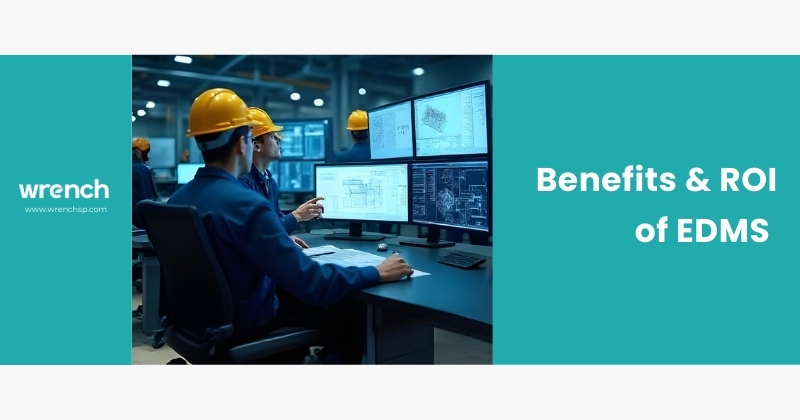Engineering DMS vs Electronic DMS

The term EDMS has become commonplace in engineering-related sectors these days, especially in EPC project verticals where the management of technical documentation is a key factor in successful project delivery.
It must be noted that EDMS in its present form is a recent development, following on the heels of the first big digital shift ie the adoption of computer-aided design (CAD) in the latter half of the last century and later on the adoption of computer-friendly file formats like MsWord and MsExcel which became more or less universal. Today the evolution of digital technology continues, with Artificial Intelligence being applied to transform project monitoring and delivery management. However, nowhere in the project cycle is the impact of digital technology felt more keenly than in the field of project documentation management.
To be clear, project documentation is not just technical data and drawings, although that forms the bulk of it. We also mean spreadsheets, reports, emails, memos, invoices and a range of other administrative and financial documents that are vital to the running of a project. But most of these documents have their own native applications, some of which have been in use for decades. We can think of such solutions as ‘generic’ document management systems, that happened to have been installed in EPC organisations and applied to engineering documents. What’s changed in recent years is the development of engineering-specific DMS, that is, a document management system pre-set to manage engineering data types and pre-loaded with engineering-specific workflows. Thus, the term EDMS, which used to be a broad term applicable to any kind of electronic document management system (or electronic data management system) has now become a type of DMS designed specifically for engineering data types and workflows only.
Over the years the distinction has deepened and naming conventions to distinguish the two have come to light, like using an uppercase E to represent Engineering and a lowercas ‘e’ to represent electronic, and now that project management software is a field in itself there seems to be an advantage in understanding such differences and differentiations. But is there really a difference in the applications themselves?
Yes, there is.
First, the similarities. EDMS and eDMS are both a kind of DMS, or document management system. They are also both digital, or electronic, in that the documents and data they deal with are digital computer files. Now the differences. An eDMS, lowercase e, typically refers to an application designed to manage documents – any kind of documents, not just engineering-related. By contrast, EDMS with an uppercase E is always related to engineering project documents, and that includes technical drawings like CAD files, spreadsheets, reports, and all the other project-related data files. Considering the size and complexity of projects documentation, the difference is not small by any means but more to the point, the type of data or type of document determines how it will be processed ie how the workflow that governs its lifecycle will be set up. This means engineering documents are processed according to an engineering workflow, and so the EDMS, by virtue of dealing with all the different types of workflows becomes a kind of aggregator of all the different software applications as well as their different data files. To put it another way; eDMS is generic, EDMS is specialised.
There’s also a difference in the effect the applications have on project operations.
An eDMS is naturally more efficient and cost-effective than the (most likely manual) mode of document management that preceded it and that means some benefits are inevitable, like being easier to use and less time-consuming. However, an EDMS goes far beyond that, requiring even less manual effort and apart from a one-time cost for set up and purchase and training, far cheaper to run in the long term. Additionally, EDMS can be used by anyone in the project lifecycle including designers, document controllers, various reviewers, and of course clients and consultants and other stakeholders. So the impact an EDMS has on the project team’s productivity is very much higher than an eDMS.
What about ease of use? Here again EDMS is a clear winner; since it is customized to one specific industry and is governed by that industry’s protocols and standards and regulations (unlike an eDMS which is industry-agnostic) the options for customizing it are greater and this makes it much more intuitive to use.
EDMS also affects compliance and quality; where an eDMS plays a largely passive role in compliance, an EDMS can be set up in such a way that it plays a role in assisting and guiding its human users based on the built-in engineering-related workflows and procedures – almost like a trusted guide and advisor that keeps you on track and doesn’t let you stray from the schedule or budget.
In conclusion, as technology for the EPC sector continues to progress in leaps and bounds understanding such distinctions could go a long way in easing the strain of digital transition.
Shabna has over 7+ years of experience in the construction project management sector, having worked with leading consultancies like AECOM, Colliers, and CBRE. She is a Civil Engineer with a Master’s degree in Building Engineering and Management from SPA, New Delhi, and has a deep understanding of project management processes with a focus on project controls and presentation.
Related Posts

Benefits & ROI of EDMS
An EDMS offers benefits in every aspect of project management and delivery, from costs to quality to customer satisfaction to brand-building. Let’s start with the first one: cost management. Lowered costs are what most often…
- 23 Apr 2025

EDMS Features and Functions
When an EPC organisation, be it an owner, architect, contractor, or consultant, starts on a journey of digital transformation the first step is likely an EDMS or engineering document management system. The expectation is that…
- 10 Apr 2025
Archives
- April 2025
- March 2025
- February 2025
- January 2025
- November 2024
- October 2024
- September 2024
- August 2024
- July 2024
- June 2024
- May 2024
- April 2024
- March 2024
- January 2024
- December 2023
- November 2023
- September 2023
- August 2023
- July 2023
- June 2023
- May 2023
- April 2023
- March 2023
- February 2023
- January 2023
- December 2022
- November 2022
- September 2022
- June 2022
- May 2022
- April 2022
- March 2022
- January 2022
- November 2021
- October 2021
- July 2021
- June 2021
- May 2021
- March 2021
- February 2021
- January 2021
- December 2020
- November 2020
- September 2020
- August 2020
- June 2020
- April 2020
- March 2020
- February 2020
- January 2020
- November 2019
- October 2019
- September 2019
- August 2019
- April 2019
- March 2019
- December 2018
- October 2018
- September 2018
- August 2018
- July 2018
- June 2018
- May 2018
- April 2018
- January 2018
- November 2017
- October 2017
- September 2017
- May 2017
- April 2017
- March 2017
- February 2017
- January 2017
